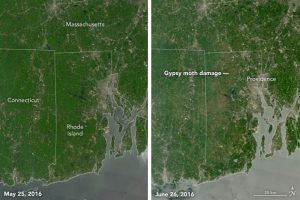NASA’s Earth Observatory posted a striking pair of pictures recently showing the massive defoliation caused by gypsy moth caterpillars in Rhode Island. It’s amazing to me how much damage the caterpillars were able to do to the tree canopy there in just a month. You can read about it and see the pictures in more detail at https://earthobservatory.nasa.gov/IOTD/view.php?id=88370.
The article describes the special importance of the dry weather they are having this year in affecting the caterpillars: “Dry weather also can weaken certain pathogens that normally keep the caterpillars in check. “This 2016 outbreak is likely due to two successive dry springs—conditions not conducive to the growth and spread of two naturally occurring bio-controls,” explained Paul Ricard, the forest health program coordinator for the Rhode Island Department of Environmental Management. “The Entomophaga maimaiga fungus and Nuclepolyhedrosis virus have historically kept the gypsy moth population in check.” Indeed, much of the Northeast was in moderate or severe drought in July 2016, according the U.S. Drought Monitor.”
